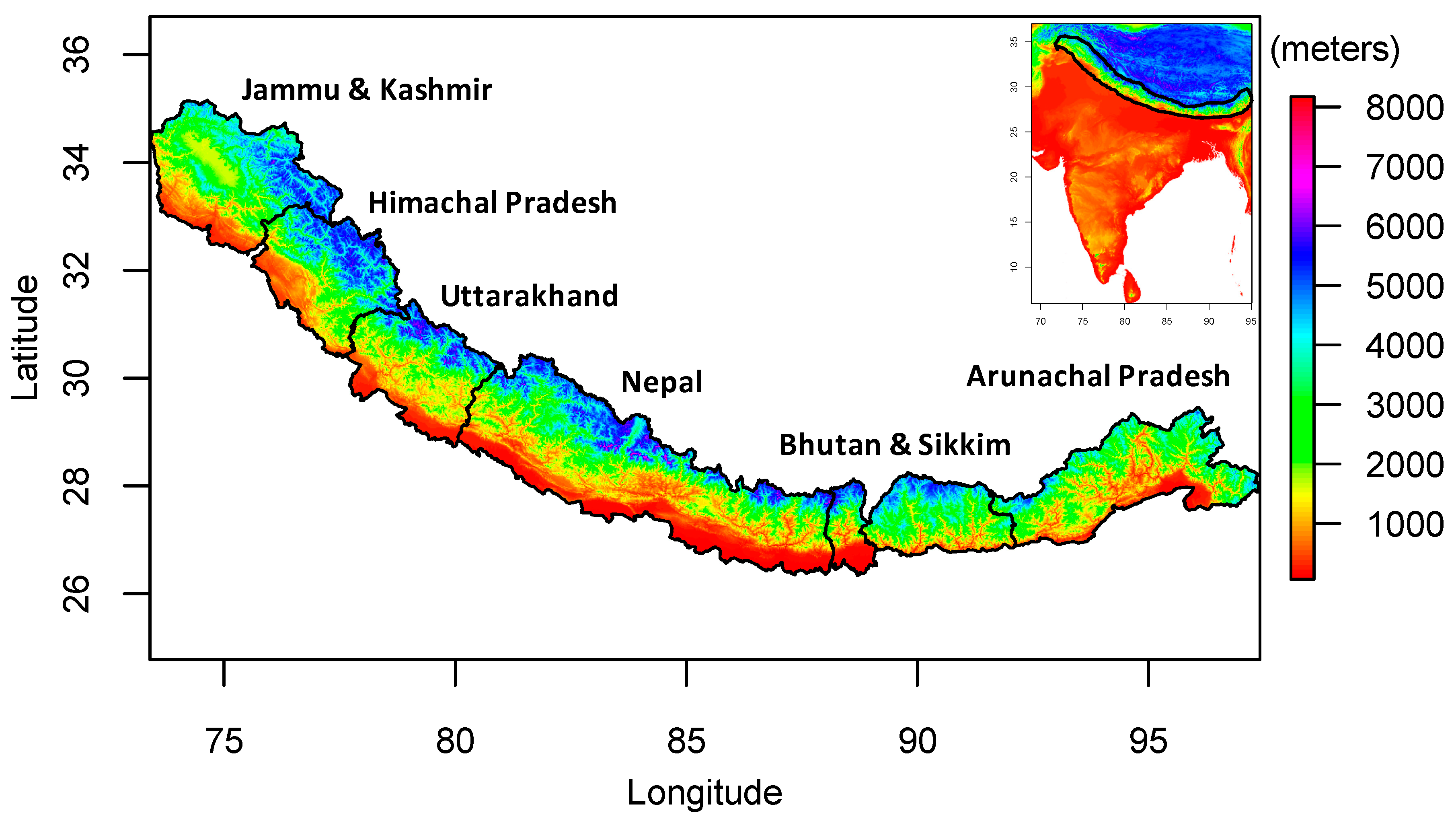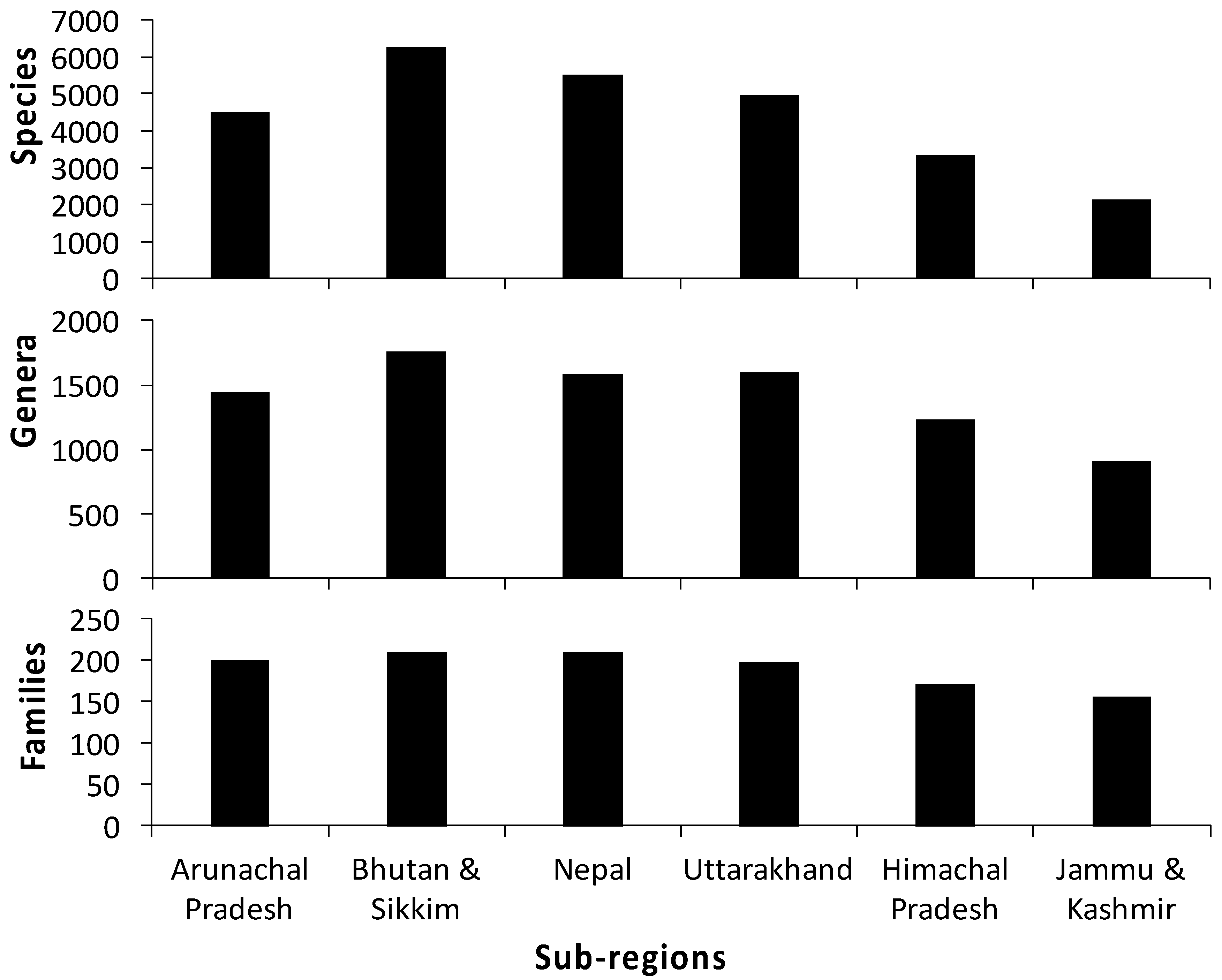Database of Himalayan Plants Based on Published Floras during a Century
Abstract
:1. Introduction
2. Data Description
3. Geographic Coverage
Bounding Coordinates: South West [26.5, 73.5], North East [35, 97]
4. Temporal Coverage
5. Taxonomic Coverage
5.1. Gymnosperms
5.2. Angiosperms
6. Methods
7. Data Summary
Acknowledgments
Author Contributions
Conflicts of Interest
Appendix A
Appendix B
References
- Singh, J.S.; Singh, S.P. Forest vegetation of the Himalaya. Bot. Rev. 1987, 53, 80–192. [Google Scholar] [CrossRef]
- Mani, M.S. Biogeography of the Himalaya. In Ecology and Biogeography of India; Springer: The Hague, The Netherlands, 1978; pp. 664–681. [Google Scholar]
- Hooker, J.D. The Flora of British India; L. Reeve: London, UK, 1875; Volume 1. [Google Scholar]
- Hooker, J.D. The Flora of British India; L. Reeve: London, UK, 1879; Volume 2. [Google Scholar]
- Hooker, J.D. The Flora of British India; L. Reeve: London, UK, 1882; Volume 3. [Google Scholar]
- Hooker, J.D. The Flora of British India; L. Reeve: London, UK, 1885; Volume 4. [Google Scholar]
- Hooker, J.D. The Flora of British India; L. Reeve: London, UK, 1890; Volume 5. [Google Scholar]
- Hooker, J.D. The Flora of British India; L. Reeve: London, UK, 1894; Volume 6. [Google Scholar]
- Hooker, J.D. The Flora of British India; L. Reeve: London, UK, 1897; Volume 7. [Google Scholar]
- Duthie, J.F. Flora of the Upper Gangetic Plain and of the Adjacent Siwalik and Sub-Himalayan Tracts; Superintendent of Government Printing, Calcutta: Calcutta, India, 1903; Volume 1.
- Duthie, J.F. Flora of the Upper Gangetic Plain and of the Adjacent Siwalik and Sub-Himalayan Tracts; Superintendent of Government Printing, Calcutta: Calcutta, India, 1911; Volume 2.
- Duthie, J.F. Flora of the Upper Gangetic Plain and of the Adjacent Siwalik and Sub-Himalayan Tracts; Superintendent of Government Printing, Calcutta: Calcutta, India, 1915; Volume 3.
- Collet, H. Flora Simlensis; Thacker, Spink & Co.: London, UK, 1921. [Google Scholar]
- Blatter, E. Beautiful Flowers of Kashmir; Staples and Staples Limited: London, UK, 1927; Volume 1. [Google Scholar]
- Blatter, E. Beautiful Flowers of Kashmir; Staples and Staples Limited: London, UK, 1928; Volume 2. [Google Scholar]
- Kanjilal, U.N. Forest Flora of the Chakrata, Dehradun and Saharanpur Forest Division; Government of India Press: Calcutta, India, 1928.
- Gupta, R.K. Flora Nainitalensis: A Handbook of the Flowering Plants of Nainital; Navayug Traders: New Delhi, India, 1968. [Google Scholar]
- Strachey, R. Catalogue of Kumaon Plants; Periodical Experts: Delhi, India, 1974. [Google Scholar]
- Babu, C.R. Herbaceous Flora of Dehradun; CSIR Publications: New Delhi, India, 1977. [Google Scholar]
- Hara, H.; Stearn, T.; Williams, L.H. J. An Enumeration of the Flowering Plants of Nepal; Trustees of the British Museum: London, UK, 1978; Volume 1. [Google Scholar]
- Hara, H.; Williams, L.H. J. An Enumeration of the Flowering Plants of Nepal; Trustees of the British Museum: London, UK, 1979; Volume 2. [Google Scholar]
- Hara, H.; Chater, A.O.; Williams, L.H. J. An Enumeration of the Flowering Plants of Nepal; Trustees of the British Museum: London, UK, 1982; Volume 3. [Google Scholar]
- Dhar, U.; Kachroo, P. Alpine Flora of Kashmir Himalaya; Scientific Publishers: Jodhpur, India, 1983. [Google Scholar]
- Grierson, A.J.C.; Long, D.G. Flora of Bhutan (Including a Record of Plants from Sikkim); Royal Botanical Garden: Edinburgh, UK, 1983; Volume 1, Part 1. [Google Scholar]
- Grierson, A.J.C.; Long, D.G. Flora of Bhutan (Including a Record of Plants from Sikkim); Royal Botanical Garden: Edinburgh, UK, 1984; Volume 1, Part 2. [Google Scholar]
- Grierson, A.J.C.; Long, D.G. Flora of Bhutan (Including a Record of Plants from Sikkim); Royal Botanical Garden: Edinburgh, UK, 1987; Volume 1, Part 3. [Google Scholar]
- Grierson, A.J.C.; Long, D.G. Flora of Bhutan (Including a Record of Plants from Sikkim); Royal Botanical Garden: Edinburgh, UK, 1991; Volume 2, Part 1. [Google Scholar]
- Grierson, A.J.C.; Long, D.G. Flora of Bhutan (Including a Record of Plants from Sikkim); Royal Botanical Garden: Edinburgh, UK, 1999; Volume 2, Part 2. [Google Scholar]
- Grierson, A.J.C.; Long, D.G. Flora of Bhutan (Including a Record of Plants from Sikkim); Royal Botanical Garden: Edinburgh, UK, 2001; Volume 2, Part 3. [Google Scholar]
- Noltie, H.J. Flora of Bhutan (Including a Record of Plants from Sikkim and Darjeeling); Royal Botanic Garden: Edinburgh, UK, 1994; Volume 3, Part 1. [Google Scholar]
- Noltie, H.J. Flora of Bhutan (Including a Record of Plants from Sikkim and Darjeeling); Royal Botanic Garden: Edinburgh, UK, 2000; Volume 3, Part 2. [Google Scholar]
- Pearce, N.R.; Cribb, P.J. Flora of Bhutan: Including a Record of Plants from Sikkim and Darjeeling; Royal Botanic Garden: Edinburgh, UK, 2002; Volume 3, Part 3. [Google Scholar]
- Chowdhery, H.J.; Wadhwa, B.M. Flora of Himachal Pradesh; Botanical Survey of India: Calcutta, India, 1984; Volume 1. [Google Scholar]
- Chowdhery, H.J.; Wadhwa, B.M. Flora of Himachal Pradesh; Botanical Survey of India: Calcutta, India, 1984; Volume 2. [Google Scholar]
- Chowdhery, H.J.; Wadhwa, B.M. Flora of Himachal Pradesh; Botanical Survey of India: Calcutta, India, 1984; Volume 3. [Google Scholar]
- Naithani, B.D. Flora of Chamoli; Botanical Survey of India: Howrah, India, 1984; Volume 1. [Google Scholar]
- Naithani, B.D. Flora of Chamoli; Botanical Survey of India: Howrah, India, 1988; Volume 2. [Google Scholar]
- Singh, G.; Kachroo, P.K. Forest Flora of Srinagar; Periodical Expert Book Agency: New Delhi, India, 1987. [Google Scholar]
- Sharma, B.M.; Jamwal, P.S. Flora of Upper Lidder Valley of Kashmir Himalaya; Scientific Publishers: Jodhpur, India, 1988; Volume 1. [Google Scholar]
- Sharma, B.M.; Jamwal, P.S. Flora of Upper Lidder Valley of Kashmir Himalaya; Scientific Publishers: Jodhpur, India, 1998; Volume 2. [Google Scholar]
- Osmaston, A.E. A Forest Flora of Kumaon; Bishen Singh Mahinder Pal Singh: Dehradun, India, 1994. [Google Scholar]
- Singh, G.; Kachroo, P. Forest Flora of Pir Panjal Range (Northwest Himalaya); Bishan Singh Mohinder Pal Singh: Dehradun, India, 1994. [Google Scholar]
- Hajra, P.K.; Balodi, B. Plant Wealth of Nanda Devi Biosphere Reserve; Botanical Survey of India: Calcutta, India, 1995. [Google Scholar]
- Chauhan, A.S.; Singh, K.P.; Singh, D.K. A Contribution to the Flora of Namdapha Arunachal Pradesh; Botanical Survey of India: Calcutta, India, 1996. [Google Scholar]
- Hajra, P.K.; Verma, D.M.; Giri, G.S. Materials for the Flora of Arunachal Pradesh; Botanical Survey of India: Culcatta, India, 1996; Volume 1. [Google Scholar]
- Giri, G.S.; Pramanik, A.; Chowdhery, H.J. Materials for the Flora of Arunachal Pradesh (Astraceae-Ceratophyllaceae); Botanical Survey of India: Calcutta, India, 2008; Volume 2. [Google Scholar]
- Chowdhery, H.J.; Giri, G.S.; Pramanik, A. Materials for the Flora of Arunachal Pradesh; Botanical Survey of India: Calcutta, India, 2009; Volume 3. [Google Scholar]
- Swami, A.; Gupta, B.K. Flora of Udhampur; Bishen Singh Mahendra Pal Singh: Dehradun, India, 1998. [Google Scholar]
- Dhaliwal, D.S.; Sharma, M. Flora of Kullu District (Himachal Pradesh); Bishen Singh Mahendra Pal Singh: Dehradun, India, 1999. [Google Scholar]
- Gaur, R.D. Flora of the District Garhwal Northwest Himalaya; Transmedia: Srinagar U.P., India, 1999. [Google Scholar]
- Singh, S.K.; Rawat, G.S. Flora of Great Himalayan National Park Himachal Pradesh; Bishen Singh Mahinder Pal Singh: Dehradun, India, 2000. [Google Scholar]
- Sharma, B.M.; Kachroo, P. Flora of Jammu and Plants of Neighborhood; Bishen Singh Mahendra Pal Singh: Dehradun, India, 1981. [Google Scholar]
- Singh, H.; Sharma, M. Flora of Chamba District Himachal Pradesh; Bishan Singh, Mohinder Pal Singh: Dehradun, India, 2006. [Google Scholar]
- Uniyal, B.P.; Sharma, J.R.; Chaudhery, U.; Singh, D.K. Flowering Plants of Uttarakhand; Bishen Singh Mahendra Pal Singh: Dehradun, India, 2007. [Google Scholar]
- Bhellum, B.L.; Magotra, R. A Catalogue of Flowering Plants of Doda, Kishtwar and Ramban Districts Kashmir Himalaya; Bishan Singh Mahenddra Pal Singh: Dehradun, India, 2012. [Google Scholar]
- Vij, S.P.; Verma, J.; Kumar, C.S. Orchids of Himachal Pradesh; Bishen Singh Mahendrapal Singh: Dehradun, India, 2013. [Google Scholar]
- Ghosh, D.K.; Mallick, J.K. Flora of Darjeeling Himalayas and Foothills (Angiosperms); Bishen Singh Mahendra Pal Singh: Dehradun, India, 2014. [Google Scholar]
- Ali, M.A.; Choudhary, R.K. India needs more plant taxonomists. Nature 2011, 471, 37. [Google Scholar]
- Kholia, B.S.; Fraser-Jenkins, C.R. Misidentification makes scientific publications worthless—Save our taxonomy and taxonomists. Curr. Sci. 2002, 100, 458–461. [Google Scholar]
- Hariharan, G.N.; Balaji, P. Taxonomic research in India: Future prospects. Curr. Sci. 2002, 83, 1068–1070. [Google Scholar]
- Dharmapalan, B. Role of funding agencies for the betterment of taxonomy. Curr. Sci. 2001, 81, 629. [Google Scholar]
- The Plant List. Version 1.1. Available online: www.theplantlist.com (accessed on 15 April 2017).
- Global Biodiversity Information Facility (GBIF). Available online: http://www.gbif.org (accessed on 3 June 2017).
- World Checklist of Selected Plant Families (WCSP). Available online: http://wcsp.science.kew.org/home.do (accessed on 18 October 2017).
- Tropicos. Available online: http://www.tropicos.org/ (accessed on 18 October 2017).


| Genus | Family | Unresolved Species | Percentage |
|---|---|---|---|
| Pedicularis | Orobanchaceae | 63 | 37.3 |
| Saxifraga | Saxifragaceae | 44 | 35.2 |
| Primula | Primulaceae | 40 | 18.1 |
| Impatiens | Balsaminaceae | 31 | 34.8 |
| Rubus | Rosaceae | 31 | 8.1 |
| Cotoneaster | Rosaceae | 25 | 6.5 |
| Potentilla | Rosaceae | 24 | 6.3 |
| Strobilanthes | Acanthaceae | 22 | 12.5 |
| Rhododendron | Ericaceae | 20 | 11.6 |
| Euphrasia | Orobanchaceae | 20 | 11.8 |
© 2017 by the authors. Licensee MDPI, Basel, Switzerland. This article is an open access article distributed under the terms and conditions of the Creative Commons Attribution (CC BY) license (http://creativecommons.org/licenses/by/4.0/).
Share and Cite
Rana, S.K.; Rawat, G.S. Database of Himalayan Plants Based on Published Floras during a Century. Data 2017, 2, 36. https://doi.org/10.3390/data2040036
Rana SK, Rawat GS. Database of Himalayan Plants Based on Published Floras during a Century. Data. 2017; 2(4):36. https://doi.org/10.3390/data2040036
Chicago/Turabian StyleRana, Suresh Kumar, and Gopal Singh Rawat. 2017. "Database of Himalayan Plants Based on Published Floras during a Century" Data 2, no. 4: 36. https://doi.org/10.3390/data2040036




